Mushrooms
Media
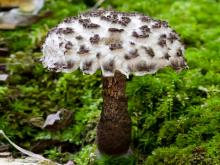
Species Types
Scientific Name
Strobilomyces floccopus
Description
The old man of the woods has a grayish black, shaggy cap with grayish pores and a grayish black, shaggy stalk. It usually grows singly, on the ground in mixed hardwood forests.
Media
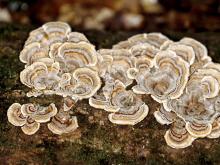
Species Types
Scientific Name
Trametes versicolor
Description
Turkey tail grows in clusters of leathery, thin brackets with multicolored zones above and whitish yellow pores below. Look for it on stumps and logs of deciduous trees.
Media

Species Types
Scientific Name
Meripilus sumstinei (formerly M. giganteus)
Description
The black-staining polypore grows in large, circular clusters of many fleshy, grayish yellow, fan-shaped caps, which bruise black when cut or touched. It grows on the ground around deciduous trees, especially oaks.
Media
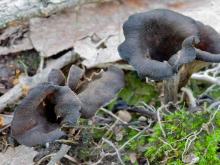
Species Types
Scientific Name
Craterellus cornucopioides (C. fallax)
Description
The black trumpet is dark brown to black, vase- or trumpet-shaped, with a wavy margin and no gills. It grows in groups of few to many on rocky, mossy hillsides in deciduous woods.
Media

Species Types
Scientific Name
Pluteus atricapillus (formerly P. cervinus)
Description
The fawn mushroom has a brownish gray cap with whitish to pinkish gills and a whitish stalk. It grows singly or scattered, on dead wood or on the ground over buried wood.
Media
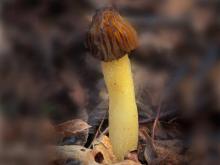
Species Types
Scientific Name
Morchella punctipes (formerly M. semilibera)
Description
The half-free morel is an excellent edible mushroom. It's completely hollow. It has a honeycombed cap with brownish black ridges and yellowish brown pits. The bottom half hangs free from the whitish stalk.
Media
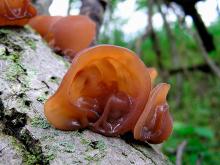
Species Types
Scientific Name
Auricularia auricula (formerly A. auricula-judae)
Description
The wood ear is a reddish brown to grayish black, rubbery, earlike or cup-shaped mushroom. It usually grows in groups on rotting wood.
Media

Species Types
Scientific Name
Morchella angusticeps (formerly M. elata)
Description
The black morel is a prized edible mushroom. It has a honeycombed cap with black to brownish black ridges and yellowish brown pits. It is completely hollow and grows in the spring.
See Also



Media

Species Types
Scientific Name
Monotropa hypopitys
Description
Pinesap is a plant that puts the "wild" in wildflower! It lacks chlorophyll, so its roots connect to fungi underground and absorb nutrients from the fungi.
Media

Species Types
Scientific Name
Cladophora, Pithophora, and Spirogyra spp., and others
Description
Filamentous green algae forms green, cottony masses that are free-floating or attached to rocks, debris, or other plants.
Media

Species Types
Scientific Name
Monotropa uniflora
Description
Indian pipe lacks chlorophyll, so it is white, not green. Below ground, its roots join with fungi that connect to tree roots. This plant, then, takes nourishment indirectly from the trees.
About Mushrooms in Missouri
Mushrooms are a lot like plants, but they lack chlorophyll and have to take nutrients from other materials. Mushrooms are neither plants nor animals. They are in a different kingdom — the fungi. Fungi include the familiar mushroom-forming species, plus the yeasts, molds, smuts, and rusts.
Always be cautious when eating edible mushrooms. Be absolutely sure of the ID, and only eat a small amount the first time you try it to avoid a reaction..





















